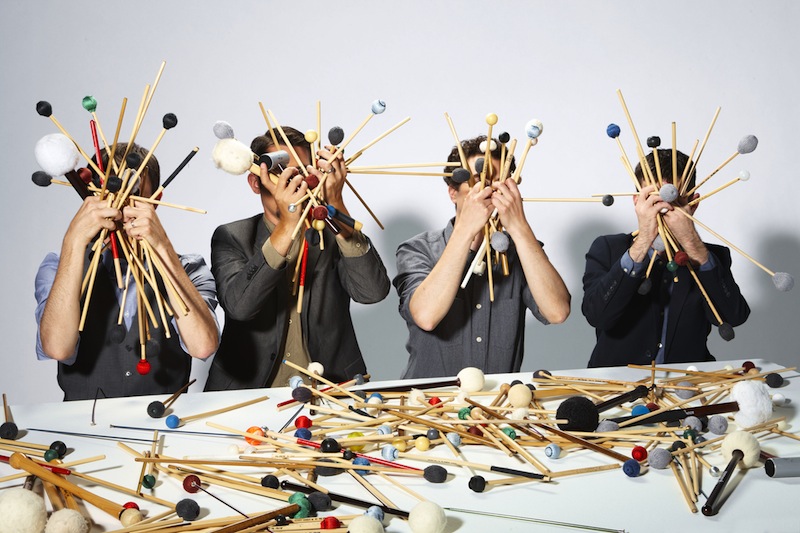Third Coast Percussion serves up a riveting Irish premiere and an American classic

Third Coast Percussion performed music of Donnacha Dennehy and Steve Reich Wednesday night at the Met Museum.
As an Irish composer, Donnacha Dennehy has first-hand experience with the bodhrán, the traditional frame drum commonly found in his home country. The instrument also happens to be featured in the Metropolitan Museum’s enormous collection of musical instruments (over 5,000 strong) from all over the world, some dating from 300 B.C.
Dennehy’s latest observations emerge in Surface Tension, written for Third Coast Percussion, which gave the New York premiere at the museum’s Grace Rainey Rogers Auditorium Wednesday night. Hearing it is a riveting experience and, as Third Coast’s Robert Dillon mused, “like being inside a volcano.”
The bodhrán looks similar to a tambourine, except larger, and is designed so one hand can stretch the surface from underneath, affecting the pitch. From this concept, and from the ensemble’s encounters with Glenn Kotche (percussionist and spine of the band Wilco) emerged an interesting phenomenon: if a sealed drum is slightly inflated, tightening the drumhead or “skin,” the original pitch of the sound can be slightly adjusted. Dennehy uses tom-toms pierced with clear plastic surgical tubing; when the player blows air into the tubes, the sound changes. Call it a drum flirting with microtonality.
For Surface Tension, Dennehy placed two of the four percussionists in the balcony (Robert Dillon and David Skidmore) and two onstage (Sean Connors and Peter Martin), to completely immerse the audience. With Connors at an array of bongos, the mood began quietly, with subtle rhythmic patterns becoming more complex. Crescendos rise and fall, with commensurate increases and decreases in pitch. It’s like observing an approaching herd of buffalo, their thuds growing fainter as they disappear into the distance.
When marimbas enter, sometimes bowed, their phosphorescence carries a mild jolt—think occasional lightning strikes—in the wake of the throbbing drums. Dynamic levels are often subdued, with the quartet’s rumblings circling the audience. But the mood can be interrupted by fortissimo barrages, such as the ferociously motoric triplets that come swaggering in, or the monolithic rhythmic unison near the end.
To complement Dennehy’s bracing new piece, the group was joined by David Friend and Oliver Hagen on keyboards for Steve Reich’s masterful Sextet. (The work is featured on the group’s upcoming Cedille recording marking the composer’s 80th birthday, along with his Mallet Quartet, Nagoya Marimbas, and Music for Pieces of Wood.)
Thirty years after its premiere at the Centre Pompidou in Paris, Reich’s jubilant half-hour work has lost none of its seductive thrills. On paper, its five sections are sheer symmetry, a modern take on sonata form: “Fast,” “Moderate,” “Slow,” “Moderate,” and “Fast.” But those analytical divisions gracefully fall away in actual performance. Sextet demands an occasional live hearing—like say, the “Eroica” or The Rite of Spring—to be reminded of what a landmark it was when it appeared.
Influenced by African rhythms, Reich combines that complexity with mildly dissonant chords to create a hypnotic arch—a journey culminating in the fifth movement’s joyful close. Though he scored Sextet for four percussionists and two keyboard players, Reich acknowledges that the percussion contingent produces “sounds of relatively short duration.” Along with electronic keyboard mimicking an electronic organ, he varies the texture with bowed marimbas. And at the slow midpoint, one has the sense of standing still, despite the continuing pulse (and the pleasingly sharp counterpoint of wooden sticks). In the composer’s words, “In music that uses a great deal of repetition, I believe it is precisely these kinds of ambiguity that give vitality and life.”
At this point, Sextet can be considered a modern milestone—not just in the world of percussion, but as a continuing testament to how Reich altered the course of 20th-century music. Based on the Third Coast crew’s energetic, yet precise reading—and the smiles tossed back and forth between the players—they have completely internalized its restless allure.
Posted Feb 11, 2016 at 4:40 pm by Bob Callahan
Very interesting, beautifully written review. Makes me wish I had been there. I must track down recordings of these works.